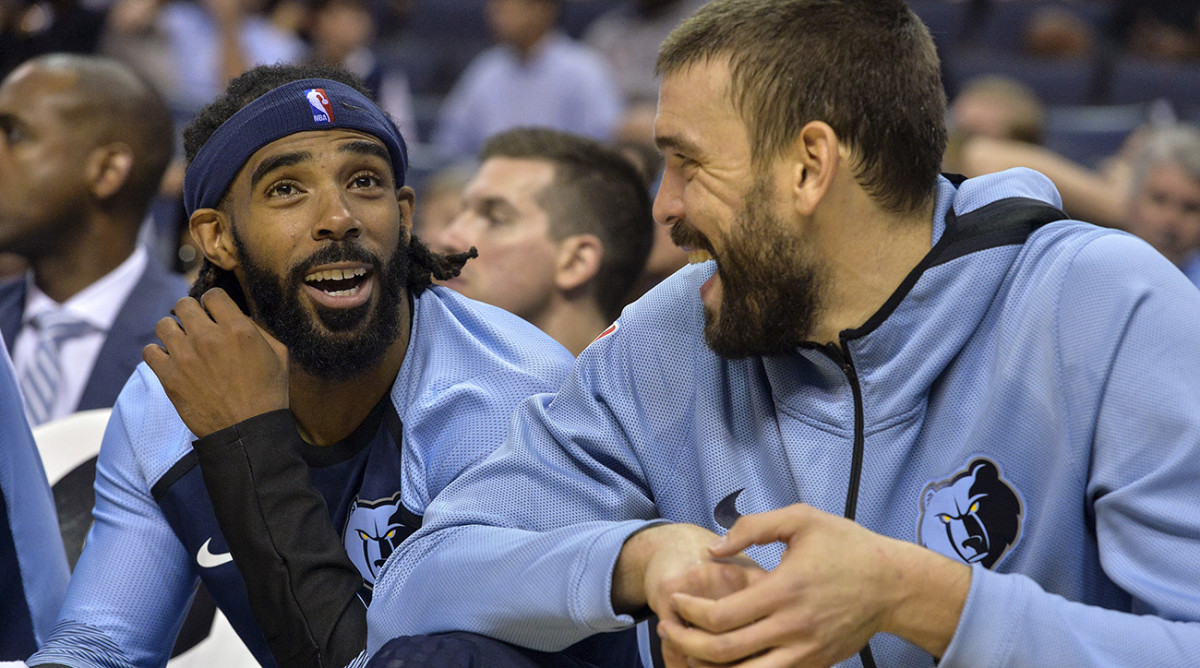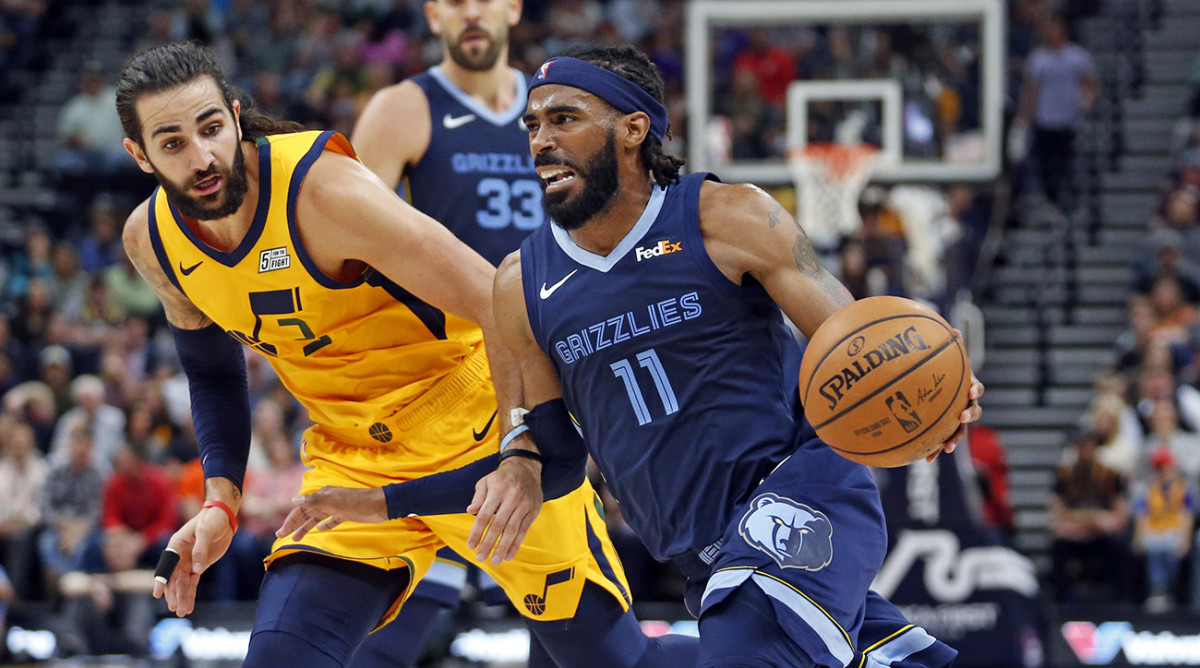Can the Grizzlies Salvage the Latter Years of the Conley-Gasol Era?

It’s not long ago that the Grit ‘N Grind era in Memphis was still running strong. The Grizzlies made a seventh straight playoff appearance in 2016–17, continuing the greatest era in franchise history. Aside from a few former contributors off at different destinations, the principles remained the same. Marc Gasol and Mike Conley hummed along as one of the league’s most artful two-man games, while an albeit-diminished Zach Randolph battled on the block. Tony Allen fell from his first-team All-Defense perch to second-team, yet by and large the Grizzlies were the West’s most reliable cog outside of San Antonio, secure with a spot in the playoffs each season.
Memphis swiped two home games from the San Antonio in the first round of the West playoffs in 2017, though what followed wasn’t a continuation, but a collapse. Randolph bolted to Sacramento in free agency and Allen signed with New Orleans that summer, leaving Conley and Gasol to pick up the pieces alongside a cast of largely unknowns. Conley’s season ended after a heel injury 13 games into last season, and second-year head coach David Fizdale was fired six games later. A 22–60 campaign marked Memphis’s worst record in a decade.

Things aren’t so bleak on Beale Street this season. Conley looks healthy and ready for another strong year—although an All-Star appearance seems less likely in the increasingly-stacked West—and Gasol is still one of the conference’s premier offensive bigs. But can this roster prove last season was an aberration, or is further change on the horizon?
Let’s start with the good news. Early returns suggest No. 4 overall pick Jaren Jackson Jr. is the real deal. The Michigan State product boasts an array of interior moves with impressive versatility, recently torching the Hawks for 24 points and seven boards on Oct. 19. The 19-year-old was unafraid of contact inside, bruising past Alex Len for a trio of hooks and pair of putbacks. Jackson continued his Summer League trend of scooting past the three-point line against Atlanta, burying two threes despite a clunky form. The headaches of a rookie big man will invariably arrive, but the skill set is there. Picking up some old tricks from Gasol should help, too, creating one of the West’s toughest twin towers.
Memphis’s talent trails off after its newfound Big 3. The backcourt and wings are bereft of scoring and skill, with significant burden on the back of second-year swingman Dillon Brooks. The Oregon product tallied 11.0 points per game as a rookie despite being a second-round pick, displaying slippery finishing ability near the tin. He caught fire from beyond the arc in December and January, but saw his production slip after the All-Star break. Brooks shot 25.8% from three in February and under 35% in both March and April, showing fatigue down the stretch.
Alongside Brooks is the streaky Garrett Temple, career journeyman Shelvin Mack and the $37 million man Kyle Anderson, who does fit into Memphis’s defensive-heavy ethos, but never made more than 19 threes in a single season. Head coach J.B. Bickerstaff will have to choose his own adventure on a night-to-night basis, weighing which lineup will boost Memphis from last year’s No. 29 points per game ranking. The future building blocks have yet to emerge.
‘What If It Does Work?’ Nick Nurse Could Be the Key to Toronto’s Reset
Memphis thought it had a quality third option in the summer of 2016, signing Chandler Parsons to a four-year, $94 million deal. An eyesore on the contract sheet today, the Parsons deal looked to be an impactful addition at the time, bringing in a wing with legitimate scoring credentials. The Florida product shot 39.5% in two years with Dallas, averaging nearly 15 points per game.
The Parsons from Dallas never made his way to Memphis. He has played in just 73 games since 2016–17, appearing in just 34 contests two years ago and 36 last year. A string of knee injuries culminated in a partial tear of the meniscus in March 2017, effectively ending the chance of a return to form. Parsons now sits as one of the league’s top albatrosses, on the books at $24 million in 2018–19 and $25 million 2019–20.
Memphis won’t be the cellar dwellers they were this season, especially at home. The Grizzlies have won over 66% of contests at the FedExForum since 2010–11, and the mind meld of Conley and Gasol can still take control late in games. Yet in as tough a conference as we’ve seen this decade, the ceiling is limited. Forget playing into the early summer, the Grizzlies are unlikely to continue their season past April 10, the last day of the regular season. The top of the conference is light years away, and the competition for the six through eight seeds far outpaces Memphis in talent. Improved Denver and New Orleans squads are unlikely to miss the playoffs, and San Antonio (a popular pick to miss the postseason for the first time since 1996–97) should keep the engine running. The Jimmy Butler drama could derail Minnesota, yet the growth of Dallas and the Clippers could vault them past the Grizz. Oh, and we haven’t even mentioned LeBron and the Lakers yet.

The Grizzlies standing near the bottom of the West provides a quandary moving past 2018–19. Conley is signed for a combined $64 million through 2020–21, and it’s unlikely teams will bite on such a large contract for a 31-year-old point guard if Memphis looks to truly hit the cellar. Expect him to stick around for the next two seasons, and even beyond if the Grizzlies look to avoid a full-blown reset. The future of his partner in crime, however, is far more dicey.
Gasol has a player option after this season, eligible to opt in to a $25 million deal in 2019–20. He can also cut ties and hit the market alongside the rest of a loaded free agent class next summer, ending his Memphis tenure after a decade with the franchise. And if the Grizzlies sit near the bottom of the league standings come January, there’s a chance they go full tank, shipping Gasol for added picks and better lottery positioning.
What could the market look like for Gasol? That’s presently unclear. Perhaps LeBron gets impatient and goes center shopping, bringing a Big Spain revival to the Staples Center just over a decade after his brother Pau joined Kobe Bryant in 2008. Miami has the assets for a potential star deal, and Gasol could be an impactful addition for a capped-out team that will sit out the summer 2019 spending spree regardless. Gasol’s player option throws another wrench into the trade market. Will the Lakers roll the dice and potentially fill a free-agent spot for a soon-to-be 34-year-old center? That may ride on James’s impatience.
The time for Grit ‘N Grind to go out with a bang has presumably passed. The key cogs are a step slower than the once were, and the role-player cast aside from Jackson isn’t as strong as it once was. Conley and Gasol’s trade market is muddied by their expensive contracts, and the league’s smallest market won’t sprint into a rebuild. The economic concerns could very well hinder what otherwise would be a teardown. The cupboards aren’t bare, but Memphis’s best days are now clearly in the rearview mirror.
